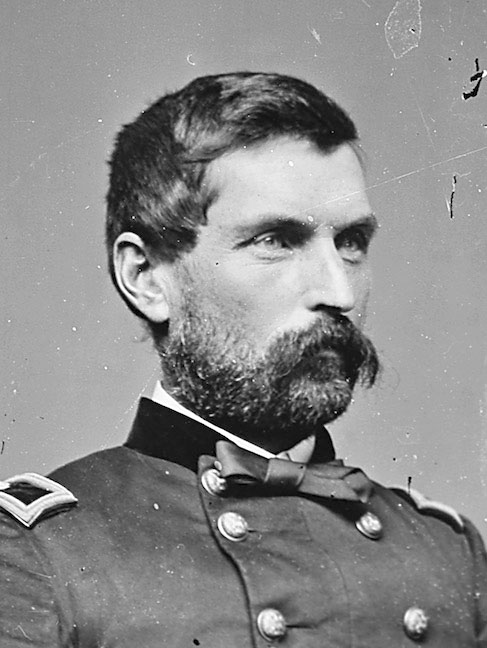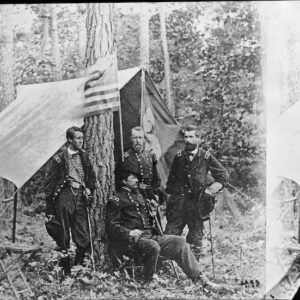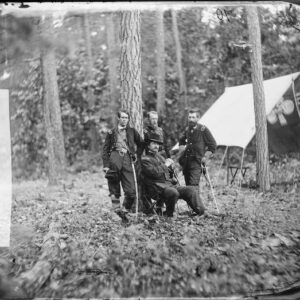Tag: Gibbon (John)
 Wikipedia says: John Gibbon (April 20, 1827 – February 6, 1896) was a career United States Army officer who fought in the American Civil War and the Indian Wars.
Wikipedia says: John Gibbon (April 20, 1827 – February 6, 1896) was a career United States Army officer who fought in the American Civil War and the Indian Wars.
…When the Civil War began, Gibbon was serving as a captain of Battery B, 4th U.S. Artillery at Camp Floyd in Utah. Although his father owned slaves and several of his family members (three brothers, two brothers-in-law and his cousin J. Johnston Pettigrew) served in the Confederate military, Gibbon remained loyal to the Union. Upon arrival in Washington, Gibbon, still in command of the 4th U.S. Artillery, became chief of artillery for Maj. Gen. Irvin McDowell. In 1862, he was appointed brigadier general of volunteers and commanded the brigade of westerners known as King’s Wisconsin Brigade. Gibbon quickly set about drilling his troops and improving their appearance, ordering them to wear white leggings and distinctive, black, 1858 regular army, Hardee hats. Their famous hats earned them the nickname, “The Black Hat Brigade”. Soldiers in his brigade despised the white leggings. While still in camp in Washington D.C., Gibbon awoke one morning to find his horse dressed in the leggings. He led the brigade into action against the famous Confederate Stonewall Brigade at the Battle of Brawner’s Farm, a prelude to the Second Battle of Bull Run. He was in command of the brigade during their strong uphill charge at the Battle of South Mountain, where Maj. Gen. Joseph Hooker exclaimed that the men “fought like iron”. From then on, the brigade was known as the “Iron Brigade”. Gibbon led the brigade at the Battle of Antietam, where he was forced to take time away from brigade command to personally man an artillery piece in the bloody fighting at the Cornfield.
Gibbon was promoted to command the 2nd Division, I Corps at the Battle of Fredericksburg in December 1862, where he was wounded. The wound was minor but was repeatedly infected, so Gibbon was on leave for a few months. Shortly after returning to duty, he learned of the sudden death of his son, John Gibbon, Jr. Gibbon returned for the Battle of Chancellorsville in May 1863, but his division was in reserve and saw little action. At the Battle of Gettysburg in July, he commanded the 2nd Division, II Corps and temporarily commanded the corps on July 2 and early July 3, 1863, while Maj. Gen. Winfield Scott Hancock was elevated to command larger units. At the end of the council of war on the night of July 2, army commander Maj. Gen. George Meade took Gibbon aside and predicted, “If Lee attacks tomorrow, it will be on your front.” Meade’s prediction proved correct; Gibbon’s division bore the brunt of Pickett’s Charge on July 3, where Gibbon was again wounded. While recovering from his wounds, he commanded a draft depot in Cleveland, Ohio, and attended the dedication of Soldiers’ National Cemetery in November 1863 with his close friend and aide Lt. Frank A. Haskell.
Gibbon was back in command of the 2nd Division during Gen. Grant’s Overland Campaign in May and June 1864, seeing action at the battles of the Wilderness, Spotsylvania Court House, and Cold Harbor. On June 7, 1864, he was promoted to major general of volunteers. During the subsequent Siege of Petersburg campaign (June 1864 to April 1865), Gibbon became disheartened when his troops refused to fight at Ream’s Station in August 1864. He briefly commanded the XVIII Corps before going on sick leave, but his service being too valuable, he returned to command the newly created XXIV Corps in the Army of the James. His troops helped achieve the decisive breakthrough at Third Battle of Petersburg in April 1865, capturing Fort Gregg, part of the Confederate defenses. During the Appomattox Campaign, he helped block the Confederate escape route at the Battle of Appomattox Courthouse, resulting in Gen. Lee’s surrender. He was one of three commissioners for the Confederate surrender.
Showing all 2 results

